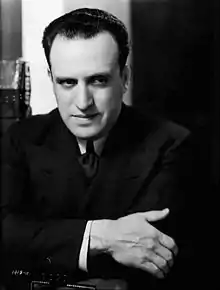Al Goodman
Alfred Goodman[1] (August 12, 1890 – January 10, 1972) was a conductor, songwriter, stage composer, musical director, arranger, and pianist.
Al Goodman Ал Гудман | |
|---|---|
 Goodman in 1938 | |
| Background information | |
| Also known as | Alfred Goodman |
| Born | August 12, 1890 Nikopol, Russian Empire (present-day Nikopol, Ukraine) |
| Died | January 10, 1972 (aged 81) New York City, USA |
| Genres | Musical |
| Occupation(s) | musical director |
| Years active | 1907–1960s |
| Labels | RCA Victor; Columbia |
Early years
Goodman was born in Nikopol, Ukraine, (another source says that he was born in Odessa, Russia).[1] His father, Tobias Goodman,[2] was a cantor in a synagogue in Odessa. Goodman sang in a choir when he was 5 years old[3] and had become fluent in reading music by age 6. When he was about 7, the family left Russia to escape a pogrom. Disguised as farmers, they made their way to Romania. There they lost their money but escaped to the United States and settled in Baltimore. Goodman graduated from Baltimore City College and the Peabody Conservatory in Baltimore. He earned money by playing piano for films at the Pickwick Theatre in Baltimore.[1]
Career
Goodman worked as a musician in a nickelodeon and chorus boy in one of the Milton Aborn's operettas.[2] Before he was 20, Goodman began working in Chicago as orchestrator for M. Witmark & Sons, a music publishing company. He moved to Los Angeles, where he began conducting in addition to composing and arranging. There, he met Al Jolson, which led to his going to New York to become Jolson's conductor.[1]
Goodman was first introduced to musical comedy by the late Earl Carroll, who persuaded him to collaborate in producing his musical, So Long Letty. The success, followed by the hit "Sinbad,"[2] which he produced with Al Jolson, led to positions as orchestra conductor for many Broadway productions including the highly successful Flyin’ High, The Student Prince, and Blossom Time. In all, during this period of his career, Goodman directed over 150 first-night performances and became one of the Great White Way's most popular conductors. He debuted as a musical director on Broadway with Canary Cottage (1917), and his final Broadway production was Hold on to Your Hats (1940).[4]
He was in such demand that it was not uncommon for him to conduct the orchestra of a show for the first few performances, and then hand the baton over to another while he prepared for a new production. In addition to his many assignments as one of RCA Victor's most talented conductors and arrangers, Goodman was kept busy directing the music for radio network shows.
Programs on which he worked included Al Goodman's Musical Album (1951-1953),[5] The Bob Hope Show,[5]:47-48 The Family Hour,[5]:113-114 The Fred Allen Show (1945-1949),[5]:121-122 The Gulf Show,[5]:141 Hit the Jackpot,[5]:152 The Intimate Revue,[5]:164 The James Melton Show,[5]:171 Palmolive Beauty Box Theater (1935-1937),[5]:264 The Prudential Family Hour,[5]:276-277 Showboat,[5]:303 Texaco Star Theater,[5]:328-329 Your Hit Parade (1935-1938),[5]:362 and The Ziegfeld Follies of the Air (1932),[5]:364
On television, Goodman worked on Colgate Comedy Hour,[6] The Donald O'Connor Show,[6]:276 Fireball Fun for All,[6]:343 and Sound Off Time.[6]:996
Goodman wrote some memorable songs such as "When Hearts Are Young", "Call of Love" and "Twilight". He also worked on several musicals such as The Band Wagon, Good News and Ziegfeld Follies.
Personal life and death
Goodman was married to Fannie Sneidman.[7] He died in New York City.
References
- "Who's Who on the Stage". The New York Times. May 10, 1925. p. X 2. Retrieved January 22, 2021 – via ProQuest.
- Spiegel, Irving (October 15, 1944). "Of Al (Not B.) Goodman". The New York Times. p. X 7. Retrieved January 22, 2021 – via ProQuest.
- Musiker, Naomi; Musiker, Reuben. Conductors and Composers of Popular Orchestral Music: A Biographical and Discographical Sourcebook. Routledge. ISBN 978-1-135-91777-7. Retrieved January 22, 2021.
- "Al Goodman". Internet Broadway Database. The Broadway League. Archived from the original on January 12, 2021. Retrieved January 22, 2021.
- Terrace, Vincent (1999). Radio Programs, 1924-1984: A Catalog of More Than 1800 Shows. McFarland & Company, Inc. p. 19. ISBN 978-0-7864-4513-4.
- Terrace, Vincent (2011). Encyclopedia of Television Shows, 1925 through 2010 (2nd ed.). Jefferson, N.C.: McFarland & Company, Inc., Publishers. p. 199. ISBN 978-0-7864-6477-7.
- "Mrs. Al Goodman". The New York Times. October 15, 1961. p. 88. Retrieved January 22, 2021 – via ProQuest.
- Book: Broadway: An Encyclopedia, by Ken Bloom